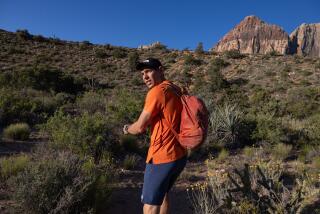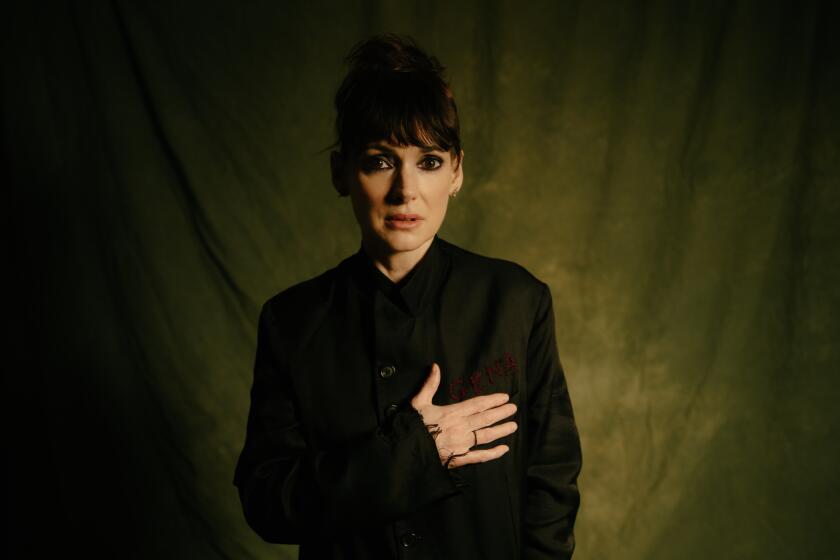Israeli filmmaker adopts camel race dream
Reporting from Jerusalem — — Ezry Keydar and Nadav Ben Israel, two Israeli filmmakers, began making a documentary last year about a Bedouin man’s dream of restoring camel races and cultural pride. But even before the film has been finished, his dream has become theirs.
Camel racing in Israel may sound outlandish, but there’s a serious point. Keydar says Israel is systematically pushing camels — a symbol of Bedouin culture — into extinction.
Keydar lives in the desert, respects its harsh ways and wants Bedouins and camels to stay part of Israel’s natural and cultural landscape. Toward this goal, Keydar is helping a dreamer produce a camel race at an abandoned desert airstrip. Besides, he can’t finish his film, “Hump,” without it.
He recently spoke to The Times about his vision.
So what do two nice Jewish guys, filmmakers, men of technology, have to do with camels and Bedouin life?
Before we are any of these things, we are people of the desert ourselves. We live in Mitzpe Ramon, the heart of the desert. As filmmakers, we document what is around us. This isn’t a film about some remote culture; these are our next-door neighbors with whom we share the same geographic space — but also another affinity. The desert is a hostile environment, a tough place to live. People living in the desert by choice, who share this life, also share a bond that is often stronger than religious belonging or other ties.
Why are the camels and Bedouin culture so important to you?
Our choice of topic is not accidental. We see these people as the last of the Mohicans — they represent a vanishing culture.
Sadly, Israel is working systematically to push this culture and its symbols into extinction. It won’t recognize camels as an agricultural sector and won’t allocate grazing lands. Commercial feed is expensive, and many Bedouins are forced to give up camels. Israel is successfully eliminating a symbol of culture. And when you kill a symbol, the culture dies with it.
We see great value in preserving this culture — not in a museum, but as a way of life. We want to see Bedouins continuing to live as people of the desert, and this is increasingly less possible. We do not want them to vanish from our landscape.
Can Bedouins still keep this way of life in a country like Israel?
It is possible. There are Bedouins who live a combination of modernity and progress on one hand and desert traditions on the other. It is not uncommon to see tents with antennas, satellite dishes, solar panels and a television, yet they preserve elements of Bedouin culture. Many Bedouins have a 4x4 pickup truck parked outside the tent, and next to it, a camel. It is a symbol of cultural pride.
Camels are a part of Bedouin culture. As a Jewish Israeli, are they really part of yours?
“If you look at the desert and see no camel, there is no desert,” says one of the characters in the film. This is really the essence of it all. I am Jewish, was not born in a tent or into the Bedouin way of life. But camels are part of the Israeli landscape itself. Look at pictures of Israel 60 years ago, there were camels everywhere. They are as much a symbol of the land as the Star of David is of the state. And you don’t strengthen one by weakening the other.
Will regional politics take to this kindly? Lebanon has already accused Israel of “stealing” falafel.
Look, I’m not presenting this as a genuinely Israeli culture. My intention is to honor a culture that is part of Israel’s natural and human landscape. [There are] 250,000 Bedouins … in the Negev. They are part of us, part of Israel. And no matter how you turn it, we are part of each other.
How has Israel treated the Bedouins?
One cannot ignore the political reality. The Bedouins are an Arab minority, one that is treated very poorly. Many communities don’t have running water or sewage infrastructure. Today, they are the poorest population, with the least education and fewest resources, and the state does nothing to bridge this tremendous gap.
Throughout its history, Israel has made every possible mistake with the Bedouins — the result of the existential fear that affects everything we do as a nation. We should rid ourselves of this fear.
Camel racing can restore Bedouin pride, but it won’t buy them groceries or belonging. How will this help?
This is only one part of the picture. People we met at camel races in Jordan, for example, explained that by honoring their forefathers’ traditions, they give their children a future too. I have no pretensions of saving the world with one film and a camel race, but I hope I succeed in adding a layer that brings closer co-existence, dialogue and knowledge of the other, both locally and regionally. Ultimately, we all live here together — Jews, Arabs, Bedouins — and these are our two cents.
Animal rights organizations took up issues with horse races and an informal camel race in recent years. How do you answer their claims?
I’d explain that our initiative is part of a larger attempt to call attention to the fact that camels are in danger of extinction not only as a symbol, but quite literally too. At the time of Israel’s foundation, tens of thousands of camels lived on the land. Today there are around 3,500, and they are slowly starving away for lack of grazing lands. Without awareness and intervention, camels could well vanish from the landscape in the near future. Besides, they are treated with love and respect by their owners.
Your idea must have raised a few eyebrows. How are local and tourism authorities reacting to your vision?
Some are very enthusiastic, like our local council; commercial bodies are less interested in sponsoring a nonprofit event. I admit, the idea is a bit esoteric — but esoteric doesn’t have to mean freakish. In Jordan and the Gulf states, camel races are classy, prestigious events.
So where does one hold a camel race in Israel?
A few years ago, work began on an airport near Mitzpe Ramon. The land was cleared and the ground leveled, but there’s no tarmac, and the project came to a halt. One day we drove by and went in. I stood on the runway and said, “Perfect! Someone spent millions for us to have just the right racetrack.” Out and back on the runway gives us a 3-kilometer [1.86-mile] circular course, absolutely classic for racing camels. They can maintain maximum speed of 60 to 70 kilometers [37.3 to 43.5 miles] per hour at these distances.
Recently, the government produced an ad that poked fun at outsiders viewing Israel stereotypically as a nation of camel riders. Did you laugh?
I found it cynical, although I can understand the humor. I might have found it funny if there hadn’t been such a sad story behind it.
Sobelman is a news assistant in The Times’ Jerusalem Bureau.
More to Read
Only good movies
Get the Indie Focus newsletter, Mark Olsen's weekly guide to the world of cinema.
You may occasionally receive promotional content from the Los Angeles Times.










